China Moves to Transform Agricultural Production, Increase Mechanization
脱贫政策英语作文

Poverty Alleviation Policies in China: APathway to ProsperityChina has made remarkable progress in poverty alleviation over the past few decades, transforming the lives of millions of its citizens. The country's commitment to eradicating poverty is evident in the various policies and strategies it has implemented, aimed at ensuring inclusive and sustainable growth.One of the key strategies adopted by China is targeted poverty alleviation, which focuses on identifying and addressing the specific needs of poor households. This approach ensures that resources are allocated effectively and reach those who need them most. In addition tofinancial assistance, targeted poverty alleviation programs also provide access to education, healthcare, and infrastructure development, among other essential services. Another significant policy is rural revitalization, which aims to transform rural areas into vibrant economic hubs. This involves improving agricultural production, promoting rural tourism, and strengthening rural infrastructure. By developing rural economies, China hopesto create more job opportunities and improve thelivelihoods of rural residents.Moreover, China has implemented a series of industrial policies to promote economic growth in poverty-stricken regions. These policies encourage the development of local industries, particularly those that create employment opportunities for the poor. By fostering economic diversification and innovation, these policies aim to transform poor regions into engines of growth and prosperity.In addition to these policies, China has also invested heavily in human capital development. This includes providing access to education, skills training, and healthcare, which are crucial for enhancing the employability and earning potential of poor individuals. By investing in human capital, China aims to break the cycle of poverty and ensure that future generations have better opportunities.The impact of these policies has been transformative. China has seen a significant reduction in poverty levels, with millions of people lifted out of poverty. Thisprogress has not only improved the lives of individuals but has also had a positive impact on society overall, reducing social tensions and fostering greater stability and harmony. In conclusion, China's poverty alleviation policieshave been instrumental in transforming the lives ofmillions of its citizens. By targeting specific needs, promoting rural revitalization, industrial development, and investing in human capital, China has created a pathway to prosperity for its poorest citizens. These policies notonly address the symptoms of poverty but also its root causes, ensuring that the benefits of growth are shared by all.**中国脱贫政策:通往繁荣的道路**在过去的几十年里,中国在脱贫方面取得了显著的进步,改变了数百万公民的生活。
中国正在不断变化英语作文
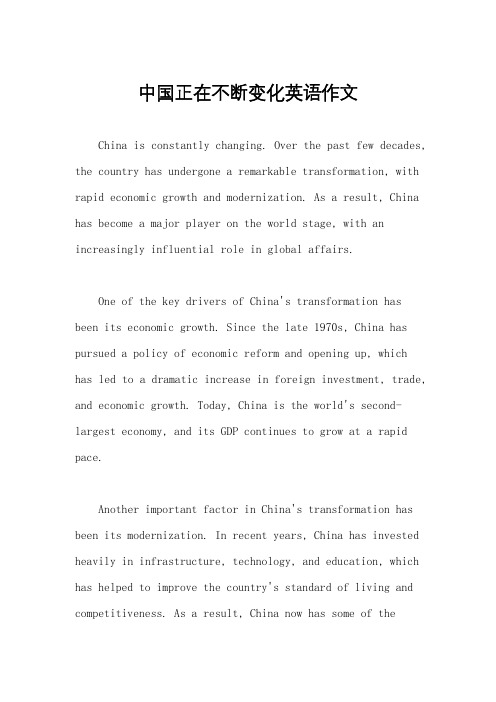
中国正在不断变化英语作文China is constantly changing. Over the past few decades, the country has undergone a remarkable transformation, with rapid economic growth and modernization. As a result, China has become a major player on the world stage, with an increasingly influential role in global affairs.One of the key drivers of China's transformation has been its economic growth. Since the late 1970s, China has pursued a policy of economic reform and opening up, which has led to a dramatic increase in foreign investment, trade, and economic growth. Today, China is the world's second-largest economy, and its GDP continues to grow at a rapid pace.Another important factor in China's transformation has been its modernization. In recent years, China has invested heavily in infrastructure, technology, and education, which has helped to improve the country's standard of living and competitiveness. As a result, China now has some of theworld's most advanced cities, transportation systems, and communication networks.Despite these achievements, China still faces many challenges. One of the biggest is the need to balance economic growth with environmental protection. China is currently the world's largest emitter of greenhouse gases, and pollution is a major problem in many parts of the country. To address these issues, China has launched a number of initiatives aimed at reducing emissions,improving energy efficiency, and promoting renewable energy.Another challenge for China is its aging population. As a result of the one-child policy, which was in place for several decades, China now has a rapidly aging population, which is expected to put significant strain on thecountry's social welfare system in the coming years. To address this issue, China has recently relaxed its one-child policy, and is now encouraging families to have more children.In conclusion, China's transformation over the past fewdecades has been remarkable. Through economic growth, modernization, and investment in infrastructure and education, China has become a major player on the world stage. However, the country still faces many challenges, including environmental protection and an aging population. Nevertheless, China's continued progress and development is sure to have a significant impact on the world in the years to come.。
中国正在发生变化英语作文
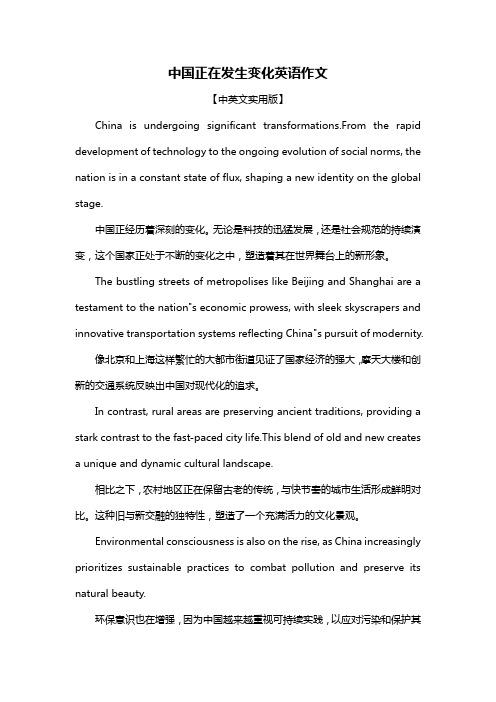
中国正在发生变化英语作文【中英文实用版】China is undergoing significant transformations.From the rapid development of technology to the ongoing evolution of social norms, the nation is in a constant state of flux, shaping a new identity on the global stage.中国正经历着深刻的变化。
无论是科技的迅猛发展,还是社会规范的持续演变,这个国家正处于不断的变化之中,塑造着其在世界舞台上的新形象。
The bustling streets of metropolises like Beijing and Shanghai are a testament to the nation"s economic prowess, with sleek skyscrapers and innovative transportation systems reflecting China"s pursuit of modernity.像北京和上海这样繁忙的大都市街道见证了国家经济的强大,摩天大楼和创新的交通系统反映出中国对现代化的追求。
In contrast, rural areas are preserving ancient traditions, providing a stark contrast to the fast-paced city life.This blend of old and new creates a unique and dynamic cultural landscape.相比之下,农村地区正在保留古老的传统,与快节奏的城市生活形成鲜明对比。
这种旧与新交融的独特性,塑造了一个充满活力的文化景观。
2023届高考英语最新热点时文阅读:网络直播:刘畊宏直播健身走红网络、滑雪小女孩王予玑滑雪视频走红
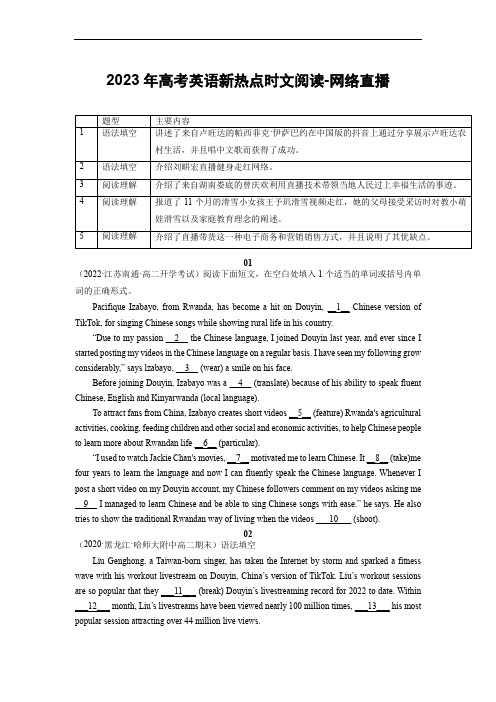
2023年高考英语新热点时文阅读-网络直播01(2022·江苏南通·高二开学考试)阅读下面短文,在空白处填入1个适当的单词或括号内单词的正确形式。
Pacifique Izabayo, from Rwanda, has become a hit on Douyin, __1__ Chinese version of TikTok, for singing Chinese songs while showing rural life in his country.“Due to my passion __2__ the Chinese language, I joined Douyin last year, and ever since I started posting my videos in the Chinese language on a regular basis. I have seen my following grow considerably,” says lzabayo, __3__ (wear) a smile on his face.Before joining Douyin, Izabayo was a __4__ (translate) because of his ability to speak fluent Chinese, English and Kinyarwanda (local language).To attract fans from China, Izabayo creates short videos __5__ (feature) Rwanda's agricultural activities, cooking, feeding children and other social and economic activities, to help Chinese people to learn more about Rwandan life __6__ (particular).“I used to watch Jackie Chan's movies, __7__ motivated me to learn Chinese. It __8__ (take)me four years to learn the language and now I can fluently speak the Chinese language. Whenever I post a short video on my Douyin account, my Chinese followers comment on my videos asking me __9__ I managed to learn Chinese and be able to sing Chinese songs with ease.” he says. He also tries to show the traditional Rwandan way of living when the videos ___10___ (shoot).02(2020·黑龙江·哈师大附中高二期末)语法填空Liu Genghong, a Taiwan-born singer, has taken the Internet by storm and sparked a fitness wave with his workout livestream on Douyin, China’s version of TikTok. Liu’s workout sessions are so popular that they ___11___ (break) Douyin’s livestreaming record for 2022 to date. Within ___12___ month, Liu’s livestreams have been viewed nearly 100 million times, ___13___ his most popular session attracting over 44 million live views.Chinese ___14___ (music) Jay Chou’s songs often serve ___15___ Liu’s background music. One of his most-watched fitness routines ___16___ (set) to “Herbalist Manual” (本草纲目) from Jay Chou’s Still Fantasy Album. “I want to slap my leg whenever I hear ‘Herbalist Manual’ now,” shared a netizen.___17___ Liu’s dance moves look simple, they are often too intense (剧烈) for his audience ___18___ (follow). Many netizens even joked that the 49-year-old was facing a popularity contest with Li Jiaqi, China’s “livestreaming king” ___19___ (know) for his sales tactics (策略). “Li Jiaqi empties our wallet, ___20___ Liu Genghong empties our body,” joked a netizen.03(2022·福建省德化第一中学高二开学考试)It is common to see most live streamers sitting in front of a desk in a well-decorated room. But Zeng Qinghuan, a 30-year old from Xinhua County in Loudi, Hunan, has turned her whole village into a live streaming set. Her goal is to use e-commerce to help her people live a better life.Known as “Xiangmei Xinbao” on Douyin, Zeng now has more than 3 million followers. One of her videos about traditional ways of planting and harvesting rice has attracted more than 300,000 followers.Zeng used to study fashion design and has worked in some big cities before. In 2019 she returned to her village to care for her sick grandmother. She then found that she could build a career there—by being a live streamer with the help of her cousin.At the beginning, she didn’t make any money. Zeng’s parents didn’t give her any support until she could stand on her own feet and help people sell their products. She has now sold local agricultural products worth tens of millions of yuan, like fermented tofu, preserved pork and dried sweet potatoes.“I’m a daughter of the great mountains. I can also be a contributor to rural development in these new times,” she said.Rural revitalization (振兴) is a key part of China’s 14th Five-Year Plan (2021-25). Zeng hopes her experience can encourage more young people to return to their rural hometowns and start their own businesses. In 2021,after she became a deputy (代表) of the Loudi Municipal People’s Congress, she put forward a proposal to ensure that “each village has one product and one live streaming host of its own”. She plans to help cultivate 100 social media influencers from her county within three years, and two villages have taken part in the project, “I believe that the rural areas will become a big stage, and being a farmer will be seen as a respectable job too,” said Zeng. 21.What do we know about Zeng’s live streaming career?A.It was encouraged by her sick grandmother.B.It brought her a fortune as soon as it was started.C.It was a great success with the help of her parents.D.It inspired more local villagers to follow.22.What is Zeng going to do from the last paragraph?A.Invite more young people to her hometown.B.Train more social media influencers in her county.C.Expand her business to make more money.D.Produce more agricultural products to help the farmers.23.Which of the following best describes Zeng?A.Down-to-earth and ambitious.B.Responsible and modest.C.Gifted and faithful.D.Caring and fashionable.24.In which column of a newspaper will you probably find the article?A.Science Study B.Travel C.Life style D.World Today04(2022·河南·濮阳一高高二期中)As the new snow season starts, enthusiastic skiers and snowboarders can’t wait to hit the trails. Among them is 11-month-old Wang Yuji, who can barely walk. A video of the girl standing on a snowboard and sliding down a hill in Zhangjiakou, Hebei province, went viral on the Internet recently.Fan Xueyin, Yuji’s mother, said it was her daughter’s first time to try snowboarding. She said she and her husband were both born in the 1980s, live and work in Beijing, and love outdoor sports such as cycling, camping and running. They hope Yuji will learn to share those interests.“As China will host the Winter Olympics soon, we are really encouraged to try ice and snow sports,” Fan said. Recently, we learned to snowboard for the first time, so we also brought our child, with the mentality of trying something new.“Our family’s philosophy has always been that we encourage our child to do whatever sports we do. We don’t choose sports that we don’t know how to do ourselves. I went snowboarding with her dad, so we got her a little snowboard too.”They initially considered waiting until Yuji was a little older, but Fan said “she really loved it”. Fan said the family has visited Thaiwoo Ski Resort in Zhangjiakou’s Chongli district many times. “Yuji has got along very well with the staff and neighbors,” she said. “Unlike living in the city, it’s wonderful for her to be able to play outside three or four hours a day here.”25.What does the underlined phrase “went viral” in the first paragraph probably mean? A.Aroused argument.B.Caused disagreement.C.Broadcast rapidly.D.Infected virus.26.Which factor motivates the couple to attempt ice and snow sports?A.They hoped their children would share those interests.B.The couple was eager to learn to snowboard.C.The Winter Olympics will take place in China soon.D.The child wanted to experience something new.27.What is the couple’s family education concept?A.Set an example for the child to follow.B.Encourage the child to do whatever she likes.C.Provide all that parents can to meet the child’s needs.D.Develop the child’s skills in an all-around level.28.Why has Fan’s family visited Thaiwoo Ski Resort many times?A.They got tired of living in the city for long.B.It is more suitable for doing sports than other resorts.C.The girl could meet new people and play heartily there.D.The first time to ski in it impressed Yuji most.05(2022·广东中山·高二期末)Livestreaming is a kind of e-commerce and marketing and sales method. It combines live product demonstrations, time-limited pricing promotions, live negotiations, and instant ordering through online streaming services hosted either by an influencer studio, or online store.Livestreaming removes barriers between brands and consumers. While it is focused on driving short term sales, livestreaming can enable firms to improve marketing efficiency by combining brand marketing and performance marketing. There are certain factors that will increase the chance of success.Brands should not use livestreaming as a short-term sales booster but as a long-term way to remove barriers between brands and consumers. Specifically, brands could better demonstrate their products in this way, tell fuller brand stories, introduce emotional and cultural elements to their products, obtain instant feedback, conduct product trials, improve marketing efficiency by combining brand marketing and performance marketing, use different livestream hosts to build a bridge for the consumers and cultivate brand loyalty.Of course, Livestreaming is not without drawbacks, however. For ads on TV, government has clear rules to forbid brands parading the before-and-after effects of health products. The restrictions are not clear yet for internet-based livestreaming, and health products are frequently promoted by livestreamers. We need to continue to monitor regulatory updates carefully.As promoting products through live-streaming has been compared to “tuning clicks into cash,” some people have made illegal profits by creating false prosperity. Through the purchase of fake followers to increase shares and comments, some live streamers can falsify their rate of engagement to cheat brands and companies in an effort to win more trust and make more money. Meanwhile, live-streams have also faced issues like the return, refund and exchange of products.29.What does the author advise the brands to do with Livestreaming?A.To achieve as much sales as possible.B.To focus more on brand marketing.C.To remove barriers between brands and consumers.D.To build a bridge between consumers and government.30.What does the underlined word “parading” probably mean?A.Overstating B.Comparing C.Displaying D.Describing 31.How do live streamers create false prosperity?A.By promoting the products as hard as possible.B.By creating fake comments and shares. C.By speaking highly of the brands and firms.D.By refusing the exchange and the refund of products.32.What’s the author’s attitude towards Livestreaming?A.Supportive B.Neutral C.Critical D.Doubtful参考答案:1.the2.for3.wearing4.translator5.featuring6.particularly7.which8.t ook9.how10.are shot/are being shot【分析】这是一篇新闻报道。
汉英翻译教程_课件_U2

二、中国时政文献翻译策略
使用被动语态 具体语境下,可考虑将原文隐含主语句的宾语或相关内容调整为译文的主
语,形成被动语态,突出原文语义重点。 例. 党的十八大以来,➊我们坚持导向为魂、移动为先、内容为王、创新
为要,➋在体制机制、政策措施、流程管理、人才技术等方面加快融合步伐, ➌建立融合传播矩阵,➍打造融合产品,➎取得了积极成效。
二、中国时政文献翻译策略
• 人才强国战略 the strategy on developing a quality workforce • 建设制造强国 to build China into a manufacturer of quality • 加快建设人才强国 to step up efforts to make China a talent-strong country • 推进体育强国建设 to build China into a country strong in sport • 实现农业大国向农业强国跨越 to transform China from a country with high agricultural output to one with a leading edge in agriculture
• 爱国统一战线 patriotic united front • 社会主义核心价值观 the core socialist values • 中国特色社会主义 socialism with Chinese characteristics
二、中国时政文献翻译策略
中国时政文献经常借助隐喻修辞或生活化语言表达具体语义,语言风格 独特,语义鲜明,在具体语境下可考虑保留原文词语的语言特色,形象传达 原文思想内容,也可以归为对应式翻译策略。
英语作文中国在变化10句
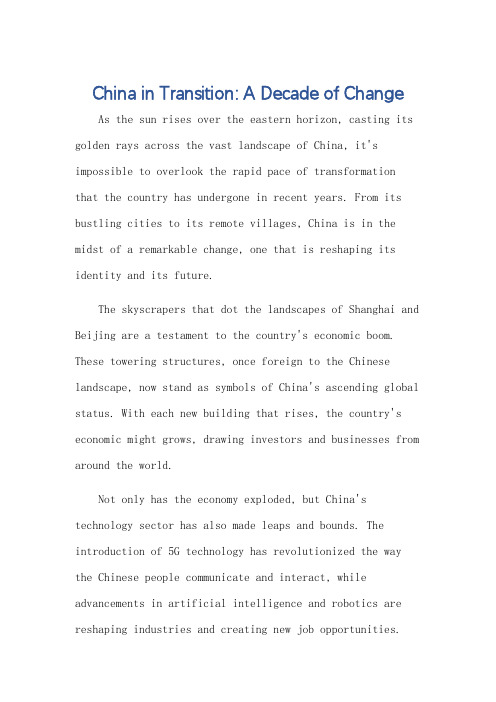
China in Transition: A Decade of ChangeAs the sun rises over the eastern horizon, casting its golden rays across the vast landscape of China, it's impossible to overlook the rapid pace of transformationthat the country has undergone in recent years. From its bustling cities to its remote villages, China is in the midst of a remarkable change, one that is reshaping its identity and its future.The skyscrapers that dot the landscapes of Shanghai and Beijing are a testament to the country's economic boom. These towering structures, once foreign to the Chinese landscape, now stand as symbols of China's ascending global status. With each new building that rises, the country's economic might grows, drawing investors and businesses from around the world.Not only has the economy exploded, but China's technology sector has also made leaps and bounds. The introduction of 5G technology has revolutionized the way the Chinese people communicate and interact, while advancements in artificial intelligence and robotics are reshaping industries and creating new job opportunities.These technological advancements are not only improving daily life but also positioning China as a leader in the global tech race.Environmentally, China has made significant strides in its efforts to become more sustainable. The government has implemented strict environmental policies, and cities like Shenzhen are leading the way in green initiatives, such as investing in renewable energy and promoting sustainable living practices. This focus on sustainability is crucial for the future of China, as it strives to balance economic growth with environmental protection.Educationally, the Chinese government has made education a priority, investing heavily in its universities and research institutions. This focus on education has fostered a generation of highly skilled and innovative individuals who are driving China's growth in areas like science, technology, engineering, and math.Culturally, China is embracing its rich heritage while also welcoming influences from around the globe. The country's rich cultural traditions are being preserved and promoted through events like the annual Spring FestivalGala, which showcases the best of Chinese culture for a global audience. At the same time, China is also welcoming foreign influences, as its cities become more diverse and international, attracting people from all over the world. In terms of infrastructure, China has built an impressive network of high-speed railways and roads that connect its vast territory, making travel more convenient and efficient. This infrastructure development has not only transformed the way people get around but has also spurred economic growth and regional development.Socially, China is becoming more inclusive and diverse. The government has implemented policies to reduce poverty and inequality, ensuring that the benefits of economic growth are shared by all. Additionally, the country is becoming more tolerant of different viewpoints and lifestyles, creating a more open and inclusive society.Globally, China's influence is growing. The country is playing an increasingly important role in international affairs, contributing to global peace and stability.China's Belt and Road Initiative is a testament to itscommitment to promoting connectivity and cooperation among nations, fostering economic growth and prosperity.As China continues to transform and evolve, it remainsa dynamic and fascinating country full of potential and promise. The changes that have taken place in recent years are only the beginning, as China moves forward with confidence and determination, shaping its future and influencing the world.**中国在变迁:十年之变**当太阳从东方升起,金色的光芒洒在中国广袤的大地上时,中国近年来的巨大变化引人注目。
中国变化发展英文作文
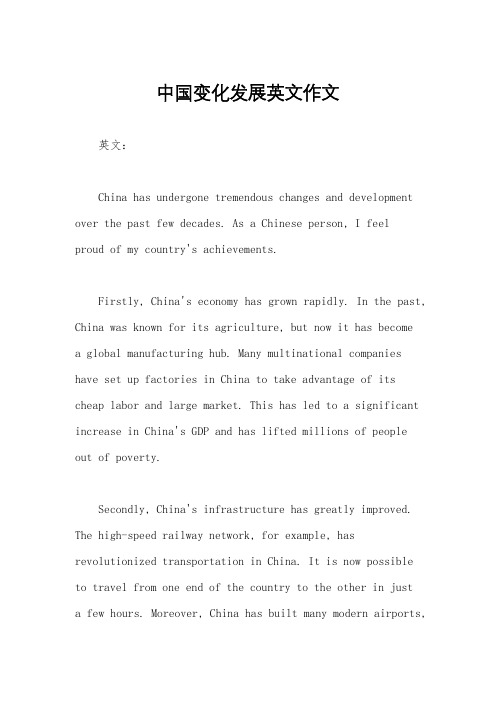
中国变化发展英文作文英文:China has undergone tremendous changes and development over the past few decades. As a Chinese person, I feelproud of my country's achievements.Firstly, China's economy has grown rapidly. In the past, China was known for its agriculture, but now it has becomea global manufacturing hub. Many multinational companies have set up factories in China to take advantage of its cheap labor and large market. This has led to a significant increase in China's GDP and has lifted millions of people out of poverty.Secondly, China's infrastructure has greatly improved. The high-speed railway network, for example, has revolutionized transportation in China. It is now possibleto travel from one end of the country to the other in justa few hours. Moreover, China has built many modern airports,highways, and bridges, making it easier for people to travel and do business.Thirdly, China's education system has also made great progress. More and more Chinese students are studying abroad and gaining knowledge and experience from different cultures. At the same time, China is investing heavily in its own universities and research institutions, which are producing world-class research and innovation.In short, China's development has been remarkable, and I believe it will continue to make great strides in the future.中文:中国在过去几十年中经历了巨大的变化和发展。
智慧中国英文演讲稿作文
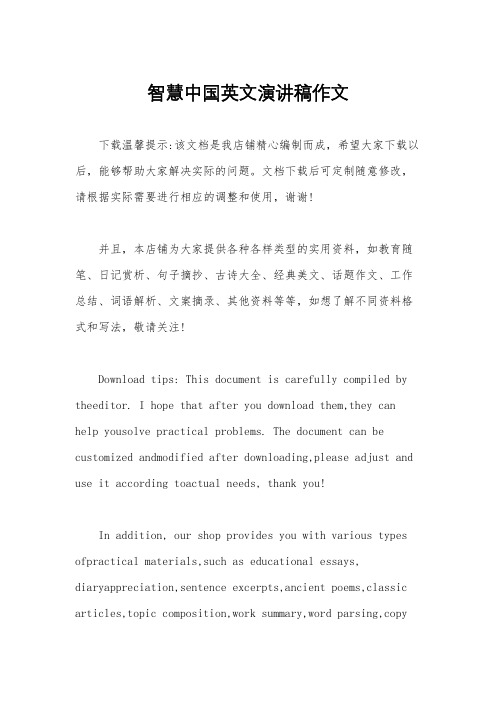
智慧中国英文演讲稿作文下载温馨提示:该文档是我店铺精心编制而成,希望大家下载以后,能够帮助大家解决实际的问题。
文档下载后可定制随意修改,请根据实际需要进行相应的调整和使用,谢谢!并且,本店铺为大家提供各种各样类型的实用资料,如教育随笔、日记赏析、句子摘抄、古诗大全、经典美文、话题作文、工作总结、词语解析、文案摘录、其他资料等等,如想了解不同资料格式和写法,敬请关注!Download tips: This document is carefully compiled by theeditor. I hope that after you download them,they can help yousolve practical problems. The document can be customized andmodified after downloading,please adjust and use it according toactual needs, thank you!In addition, our shop provides you with various types ofpractical materials,such as educational essays, diaryappreciation,sentence excerpts,ancient poems,classic articles,topic composition,work summary,word parsing,copyexcerpts,other materials and so on,want to know different data formats andwriting methods,please pay attention!In today's rapidly changing world, China is striving to become a smarter nation. With advancements in technology, innovation, and education, China is embracing the concept of a "Smart China." This vision encompasses various aspects of society, including smart cities, smart transportation, smart agriculture, and smart healthcare. The aim is to create a more efficient, sustainable, and intelligent society.In the realm of smart cities, China is leading the way. With the development of technologies such as artificial intelligence, big data, and the Internet of Things, cities are becoming more interconnected and intelligent. Smartcity initiatives focus on improving urban infrastructure, enhancing public services, and promoting sustainable development. From smart traffic management systems to intelligent waste management, China is harnessing the power of technology to create a better living environment for its citizens.Transportation is another area where China is making significant strides. With the introduction of high-speedrail networks, smart traffic systems, and electric vehicles, China is revolutionizing the way people travel. The integration of technology into transportation systems has not only improved efficiency but also reduced carbon emissions. Smart transportation solutions such asintelligent traffic lights and real-time navigation systems have made commuting easier and more convenient for millions of people.In the agricultural sector, China is leveraging technology to increase productivity and ensure food security. Smart farming techniques, such as precision agriculture and hydroponics, are being implemented to optimize resource utilization and reduce environmental impact. Drones and satellite imagery are being used to monitor crop health and detect pests and diseases. By embracing these innovations, China aims to transform its agricultural sector and ensure a sustainable food supplyfor its growing population.Healthcare is another area where China is embracing smart solutions. With an aging population and increasing healthcare demands, China is turning to technology to improve the quality and accessibility of healthcare services. Telemedicine, wearable devices, and health monitoring apps are being used to provide remote healthcare services and enable early detection of diseases. Artificial intelligence is also being utilized to analyze medical data and assist in diagnosis and treatment.In conclusion, China's pursuit of a smarter nation is evident in various aspects of society. From smart cities to smart transportation, smart agriculture, and smart healthcare, China is harnessing the power of technology to create a more efficient, sustainable, and intelligent society. By embracing these innovations, China is not only improving the lives of its citizens but also setting an example for the rest of the world. The future of a smarter China looks promising, and it is exciting to witness the transformation taking place.。
初三英语作文范文10篇乡村振兴
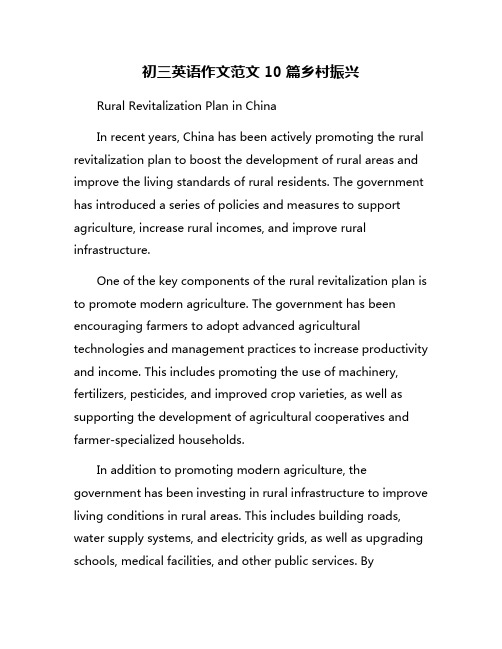
初三英语作文范文10篇乡村振兴Rural Revitalization Plan in ChinaIn recent years, China has been actively promoting the rural revitalization plan to boost the development of rural areas and improve the living standards of rural residents. The government has introduced a series of policies and measures to support agriculture, increase rural incomes, and improve rural infrastructure.One of the key components of the rural revitalization plan is to promote modern agriculture. The government has been encouraging farmers to adopt advanced agricultural technologies and management practices to increase productivity and income. This includes promoting the use of machinery, fertilizers, pesticides, and improved crop varieties, as well as supporting the development of agricultural cooperatives and farmer-specialized households.In addition to promoting modern agriculture, the government has been investing in rural infrastructure to improve living conditions in rural areas. This includes building roads, water supply systems, and electricity grids, as well as upgrading schools, medical facilities, and other public services. Byimproving rural infrastructure, the government aims to attract more people to live and work in rural areas and boost local economic development.Another important focus of the rural revitalization plan is to promote rural tourism and cultural heritage preservation. The government has been promoting rural tourism by developing scenic spots, homestays, and cultural experiences in rural areas. This not only helps to attract visitors and generate income for local residents, but also promotes the preservation of traditional culture and heritage.Furthermore, the government has been supporting rural entrepreneurship and innovation to stimulate economic growth in rural areas. This includes providing financial support, training, and mentorship for rural entrepreneurs, as well as facilitating technology transfer and knowledge exchange between urban and rural areas.Overall, the rural revitalization plan in China aims to transform rural areas into prosperous, environmentally friendly, and culturally rich communities. By promoting modern agriculture, improving rural infrastructure, developing rural tourism and cultural heritage, and supporting ruralentrepreneurship and innovation, the government hopes to achieve sustainable and inclusive rural development.In conclusion, the rural revitalization plan in China is a comprehensive strategy that seeks to address the challenges facing rural areas and promote their sustainable development. By investing in modern agriculture, improving rural infrastructure, promoting rural tourism and cultural heritage, and supporting rural entrepreneurship and innovation, the government is working towards creating a better future for rural residents and boosting the overall development of the country.。
中国发生翻天覆地的变化英语作文
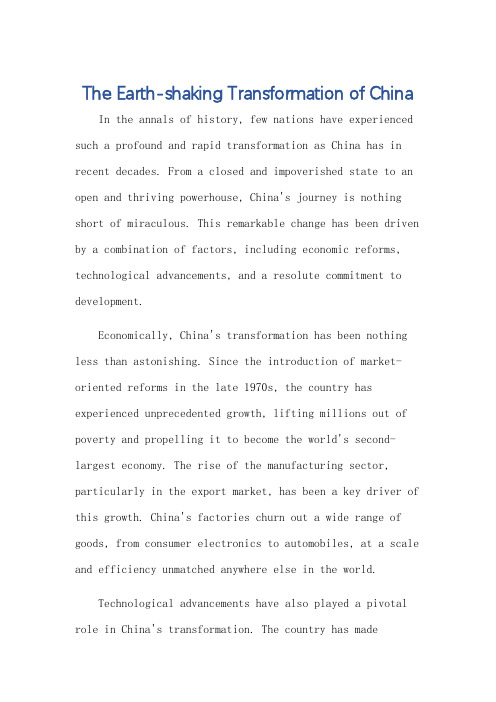
The Earth-shaking Transformation of China In the annals of history, few nations have experienced such a profound and rapid transformation as China has in recent decades. From a closed and impoverished state to an open and thriving powerhouse, China's journey is nothing short of miraculous. This remarkable change has been driven by a combination of factors, including economic reforms, technological advancements, and a resolute commitment to development.Economically, China's transformation has been nothing less than astonishing. Since the introduction of market-oriented reforms in the late 1970s, the country has experienced unprecedented growth, lifting millions out of poverty and propelling it to become the world's second-largest economy. The rise of the manufacturing sector, particularly in the export market, has been a key driver of this growth. China's factories churn out a wide range of goods, from consumer electronics to automobiles, at a scale and efficiency unmatched anywhere else in the world.Technological advancements have also played a pivotal role in China's transformation. The country has madesignificant investments in research and development, resulting in groundbreaking innovations in fields like artificial intelligence, robotics, and renewable energy. Chinese companies like Huawei and Alibaba are now global leaders in these fields, demonstrating the country's technological prowess.Moreover, China's commitment to development has been unwavering. The government has implemented a series of policies and programs aimed at improving the lives of its citizens, including poverty alleviation initiatives, education reforms, and infrastructure development. The result is a society that is more prosperous, educated, and connected than ever before.The transformation of China has not been without challenges, however. Environmental degradation, social inequality, and political tensions have been some of the major concerns. The country faces the dual challenge of maintaining its economic growth while addressing these issues.Despite these challenges, China's future looks bright. With a young and increasingly educated workforce, a vibrantentrepreneurial culture, and a strong commitment to innovation and development, the country is poised to continue its remarkable transformation into a global powerhouse.**中国翻天覆地的变化**在历史的长河中,很少有国家能像中国近几十年来所经历的那样,发生如此深刻和迅速的变化。
关于中国农村变化英语作文
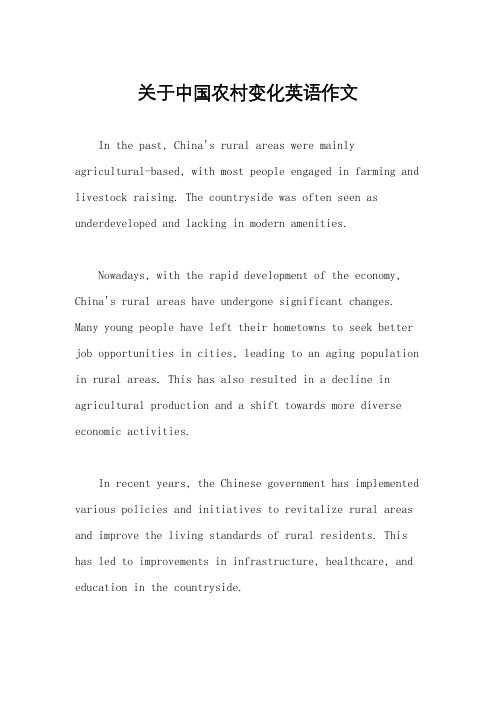
关于中国农村变化英语作文In the past, China's rural areas were mainly agricultural-based, with most people engaged in farming and livestock raising. The countryside was often seen as underdeveloped and lacking in modern amenities.Nowadays, with the rapid development of the economy, China's rural areas have undergone significant changes. Many young people have left their hometowns to seek better job opportunities in cities, leading to an aging population in rural areas. This has also resulted in a decline in agricultural production and a shift towards more diverse economic activities.In recent years, the Chinese government has implemented various policies and initiatives to revitalize rural areas and improve the living standards of rural residents. This has led to improvements in infrastructure, healthcare, and education in the countryside.The rise of e-commerce and online platforms has also brought new opportunities to rural residents, allowing them to sell agricultural products and handicrafts to a wider market. This has helped to boost the income of rural households and reduce the wealth gap between urban andrural areas.Despite these changes, challenges remain in China's rural areas, such as environmental degradation, lack of access to modern technology, and insufficient social welfare support. Efforts are being made to address these issues and create a more sustainable and inclusive rural development model.In conclusion, the transformation of China's rural areas reflects the country's overall economic and social progress. While there have been positive changes, it is important to continue addressing the remaining challenges and ensuring that rural residents can fully benefit from the opportunities brought about by development.。
中国在农业的发展的英语作文
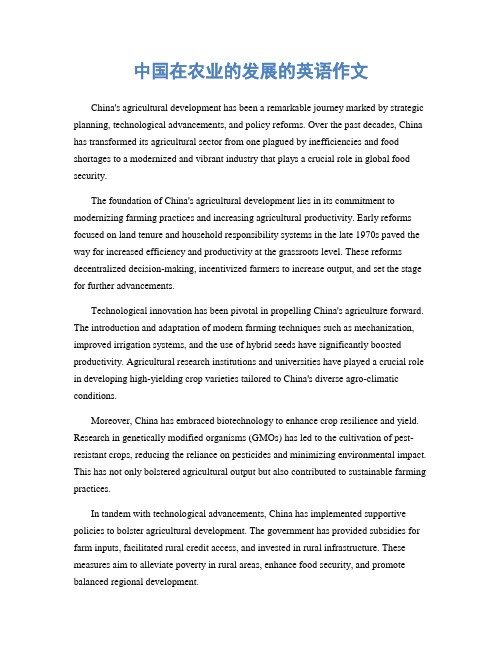
中国在农业的发展的英语作文China's agricultural development has been a remarkable journey marked by strategic planning, technological advancements, and policy reforms. Over the past decades, China has transformed its agricultural sector from one plagued by inefficiencies and food shortages to a modernized and vibrant industry that plays a crucial role in global food security.The foundation of China's agricultural development lies in its commitment to modernizing farming practices and increasing agricultural productivity. Early reforms focused on land tenure and household responsibility systems in the late 1970s paved the way for increased efficiency and productivity at the grassroots level. These reforms decentralized decision-making, incentivized farmers to increase output, and set the stage for further advancements.Technological innovation has been pivotal in propelling China's agriculture forward. The introduction and adaptation of modern farming techniques such as mechanization, improved irrigation systems, and the use of hybrid seeds have significantly boosted productivity. Agricultural research institutions and universities have played a crucial role in developing high-yielding crop varieties tailored to China's diverse agro-climatic conditions.Moreover, China has embraced biotechnology to enhance crop resilience and yield. Research in genetically modified organisms (GMOs) has led to the cultivation of pest-resistant crops, reducing the reliance on pesticides and minimizing environmental impact. This has not only bolstered agricultural output but also contributed to sustainable farming practices.In tandem with technological advancements, China has implemented supportive policies to bolster agricultural development. The government has provided subsidies for farm inputs, facilitated rural credit access, and invested in rural infrastructure. These measures aim to alleviate poverty in rural areas, enhance food security, and promote balanced regional development.Furthermore, China's agricultural sector has undergone structural adjustments to meet changing consumer demands and global market trends. The rise of middle-class consumers has led to increased demand for diversified and high-quality agricultural products. This shift has prompted farmers to adopt new production methods and diversify their crops to cater to domestic and international markets.Environmental sustainability has also become a focal point of China's agricultural policies. Efforts to promote eco-friendly farming practices, such as organic farming and precision agriculture, aim to minimize environmental degradation while maintaining productivity. Water conservation strategies and soil health management have become integral parts of agricultural practices nationwide.China's agricultural development has not been without challenges. Issues such as land fragmentation, water scarcity, rural-urban migration, and climate change pose ongoing threats to agricultural sustainability. However, the government continues to address these challenges through targeted policies, technological innovation, and international cooperation.Looking ahead, China remains committed to furthering agricultural modernization and ensuring food security for its vast population. Strategic initiatives such as the Rural Revitalization Strategy aim to integrate agriculture with rural development, promote agricultural efficiency, and improve farmers' livelihoods. By harnessing technological innovation, policy support, and sustainable practices, China is poised to continue its leadership in global agricultural development.In conclusion, China's agricultural journey underscores a remarkable transformation from subsistence farming to a dynamic, technology-driven sector. Through strategic reforms, technological innovation, supportive policies, and sustainable practices, China has not only achieved food security but also positioned itself as a key player in global agricultural development. As challenges persist, China's commitment to innovation and sustainability ensures a resilient future for its agricultural sector and contributes significantly to global food security efforts.。
中国农村的变化的英语作文
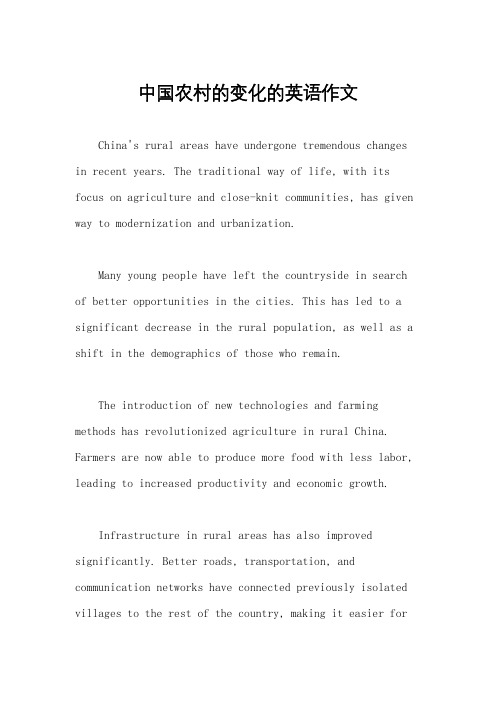
中国农村的变化的英语作文China's rural areas have undergone tremendous changes in recent years. The traditional way of life, with its focus on agriculture and close-knit communities, has given way to modernization and urbanization.Many young people have left the countryside in search of better opportunities in the cities. This has led to a significant decrease in the rural population, as well as a shift in the demographics of those who remain.The introduction of new technologies and farming methods has revolutionized agriculture in rural China. Farmers are now able to produce more food with less labor, leading to increased productivity and economic growth.Infrastructure in rural areas has also improved significantly. Better roads, transportation, and communication networks have connected previously isolated villages to the rest of the country, making it easier forgoods and services to flow in and out.The standard of living in rural China has risen as a result of these changes. Access to education, healthcare, and other basic services has improved, and people in the countryside now have a higher quality of life than before.Despite these advancements, challenges remain. Environmental degradation, lack of sustainable development, and income inequality are issues that continue to affect rural China and its inhabitants.In conclusion, the transformation of rural China has been profound and far-reaching. While there have been many positive changes, there are still obstacles to overcome in order to ensure a sustainable and equitable future for the country's rural population.。
中国式现代化的人与自然和谐共生英语作文
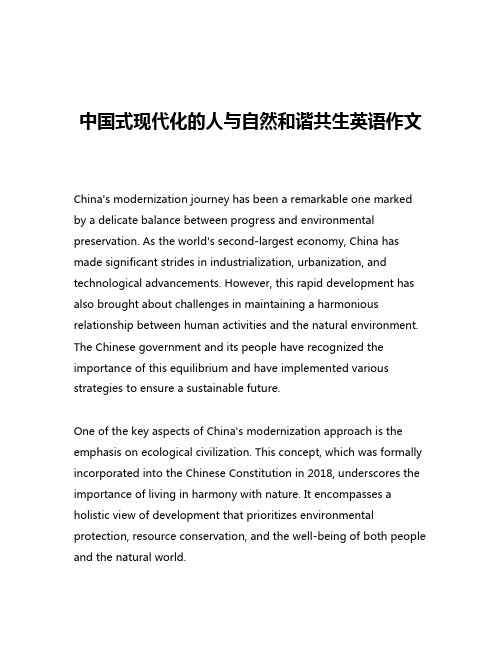
中国式现代化的人与自然和谐共生英语作文China's modernization journey has been a remarkable one marked by a delicate balance between progress and environmental preservation. As the world's second-largest economy, China has made significant strides in industrialization, urbanization, and technological advancements. However, this rapid development has also brought about challenges in maintaining a harmonious relationship between human activities and the natural environment. The Chinese government and its people have recognized the importance of this equilibrium and have implemented various strategies to ensure a sustainable future.One of the key aspects of China's modernization approach is the emphasis on ecological civilization. This concept, which was formally incorporated into the Chinese Constitution in 2018, underscores the importance of living in harmony with nature. It encompasses a holistic view of development that prioritizes environmental protection, resource conservation, and the well-being of both people and the natural world.At the forefront of this initiative is the Chinese government's commitment to addressing climate change and promoting renewable energy sources. China has emerged as a global leader in the production and utilization of renewable energy, with a particular focus on solar and wind power. The country has set ambitious targets to increase its renewable energy capacity and reduce its carbon emissions, demonstrating a strong determination to transition towards a low-carbon economy.Moreover, China has made significant investments in urban planning and infrastructure development that prioritize sustainability. Cities across the country are embracing green building practices, implementing efficient public transportation systems, and developing extensive urban green spaces. These efforts not only enhance the quality of life for residents but also contribute to the overall ecological balance.Another remarkable aspect of China's modernization is the integration of traditional Chinese philosophies and practices into its development strategies. Concepts such as the Taoist principle of "harmony between man and nature" and the Confucian emphasis on environmental stewardship have been revived and incorporated into modern policymaking. This approach has led to a deeper understanding and appreciation of the intrinsic value of the natural world, fostering a sense of responsibility and reverence among theChinese people.One such example is the widespread adoption of traditional agricultural practices, such as organic farming and agroforestry, which promote sustainable land use and the preservation of biodiversity. These practices not only ensure food security but also contribute to the restoration and conservation of natural habitats, providing a harmonious coexistence between human activities and the environment.Furthermore, China has made significant investments in environmental protection and restoration efforts. The country has established extensive national parks, nature reserves, and ecological corridors to safeguard biodiversity and protect vulnerable ecosystems. The "Sponge City" initiative, for instance, aims to transform urban areas into water-resilient environments that can absorb, store, and purify stormwater, mitigating the impact of flooding and promoting sustainable water management.These comprehensive efforts have yielded tangible results. In recent years, China has experienced improvements in air quality, water quality, and the overall health of its natural environments. The country has also made strides in addressing environmental challenges such as desertification, deforestation, and wildlife conservation.However, it is important to recognize that the journey towards a harmonious coexistence between man and nature in China's modernization is an ongoing process. Challenges such as rapid urbanization, industrial pollution, and resource depletion continue to pose threats to the delicate balance. The Chinese government and its people must remain vigilant and committed to addressing these challenges through innovative policies, technological advancements, and collaborative efforts.In conclusion, China's approach to modernization has demonstrated a remarkable commitment to sustainable development and the harmonious coexistence of man and nature. By integrating traditional philosophies, embracing renewable energy, and implementing comprehensive environmental protection measures, China has set an example for the world on how to balance economic progress with ecological preservation. As the country continues to navigate the complexities of modernization, its dedication to this harmonious relationship will be crucial in shaping a more sustainable and resilient future for its people and the planet.。
中国的发展腾飞英语作文
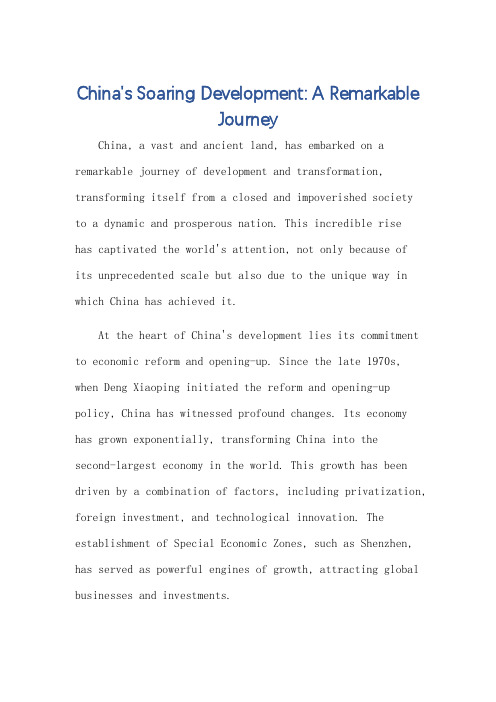
China's Soaring Development: A RemarkableJourneyChina, a vast and ancient land, has embarked on a remarkable journey of development and transformation, transforming itself from a closed and impoverished societyto a dynamic and prosperous nation. This incredible risehas captivated the world's attention, not only because ofits unprecedented scale but also due to the unique way in which China has achieved it.At the heart of China's development lies its commitment to economic reform and opening-up. Since the late 1970s, when Deng Xiaoping initiated the reform and opening-up policy, China has witnessed profound changes. Its economy has grown exponentially, transforming China into thesecond-largest economy in the world. This growth has been driven by a combination of factors, including privatization, foreign investment, and technological innovation. The establishment of Special Economic Zones, such as Shenzhen, has served as powerful engines of growth, attracting global businesses and investments.Another key aspect of China's development has been its focus on infrastructure development. The country has embarked on a massive infrastructure building spree, investing heavily in roads, railways, bridges, airports, and ports. This has not only improved connectivity within the country but also enhanced its global competitiveness. The development of the Belt and Road Initiative, a global infrastructure network connecting Asia, Europe, and Africa, further underscores China's commitment to regional and global integration.Moreover, China's rise has been fueled by its strong commitment to education and scientific research. The country has invested heavily in building a highly skilled workforce and fostering a culture of innovation. This has led to significant advancements in fields such asartificial intelligence, quantum computing, and renewable energy. Chinese companies like Alibaba and Tencent have emerged as global technology leaders, demonstrating the country's capabilities in the digital age.However, China's development has not been without challenges. Issues such as environmental degradation,income inequality, and social unrest have emerged as significant concerns. The country is now grappling with the dual challenge of maintaining its economic growth while addressing these pressing issues. This requires a balance between further economic development and social progress, ensuring that the benefits of growth are shared by all.Despite these challenges, China's development remainsan inspiration to many developing countries. Its success story demonstrates that with strong leadership, a commitment to reform, and a focus on innovation, even the most impoverished nations can achieve remarkable progress. China's journey also underscores the importance of global cooperation and integration in today's interconnected world. In conclusion, China's soaring development is a remarkable achievement that has transformed the country and influenced the global landscape. Its commitment to economic reform, infrastructure development, and scientific research has been the driving force behind this transformation.While challenges remain, China's development continues to inspire and provide valuable lessons for other countries.**中国的发展腾飞:一段非凡的旅程**中国,这片辽阔而古老的土地,已经踏上了一段非凡的发展腾飞之旅,从封闭贫穷的社会转变为充满活力和繁荣的国家。
中国乡村变化英文作文
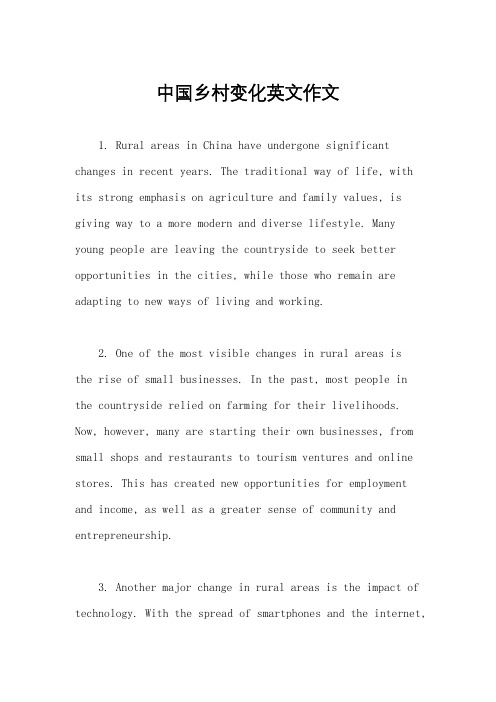
中国乡村变化英文作文1. Rural areas in China have undergone significant changes in recent years. The traditional way of life, with its strong emphasis on agriculture and family values, is giving way to a more modern and diverse lifestyle. Many young people are leaving the countryside to seek better opportunities in the cities, while those who remain are adapting to new ways of living and working.2. One of the most visible changes in rural areas isthe rise of small businesses. In the past, most people in the countryside relied on farming for their livelihoods. Now, however, many are starting their own businesses, from small shops and restaurants to tourism ventures and online stores. This has created new opportunities for employment and income, as well as a greater sense of community and entrepreneurship.3. Another major change in rural areas is the impact of technology. With the spread of smartphones and the internet,people in even the most remote villages can now access information, connect with others, and participate in online commerce. This has opened up new possibilities for education, healthcare, and entertainment, as well as new challenges in terms of privacy, security, and digital literacy.4. Despite these changes, however, many rural areas in China still face significant challenges. Poverty, inequality, and environmental degradation remain major issues, especially in the less developed regions of the country. Moreover, the rapid pace of change has created a sense of dislocation and uncertainty for many people, who feel caught between the old and the new.5. In conclusion, the transformation of rural areas in China reflects both the opportunities and the challenges of modernization. While there is much to celebrate in terms of innovation, diversity, and resilience, there is also a need to address the social, economic, and environmental issues that continue to affect many communities. Only by workingtogether can we ensure that the benefits of progress are shared by all.。
中国自立自强的英语作文
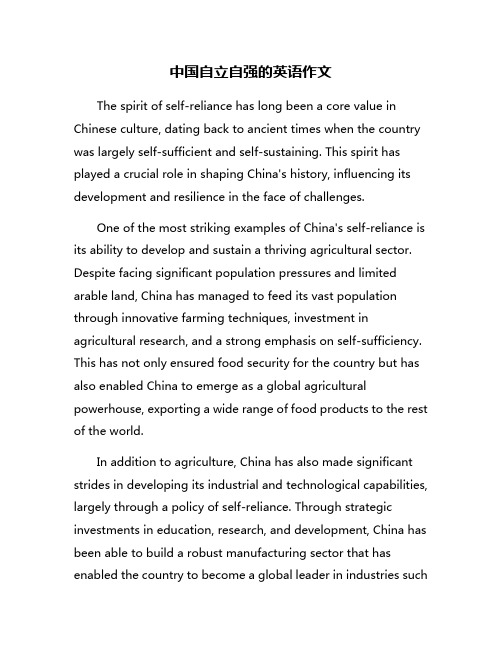
中国自立自强的英语作文The spirit of self-reliance has long been a core value in Chinese culture, dating back to ancient times when the country was largely self-sufficient and self-sustaining. This spirit has played a crucial role in shaping China's history, influencing its development and resilience in the face of challenges.One of the most striking examples of China's self-reliance is its ability to develop and sustain a thriving agricultural sector. Despite facing significant population pressures and limited arable land, China has managed to feed its vast population through innovative farming techniques, investment in agricultural research, and a strong emphasis on self-sufficiency. This has not only ensured food security for the country but has also enabled China to emerge as a global agricultural powerhouse, exporting a wide range of food products to the rest of the world.In addition to agriculture, China has also made significant strides in developing its industrial and technological capabilities, largely through a policy of self-reliance. Through strategic investments in education, research, and development, China has been able to build a robust manufacturing sector that has enabled the country to become a global leader in industries suchas electronics, automobiles, and renewable energy. This has not only boosted China's economic growth but has also positioned the country as a key player in the global economy.China's commitment to self-reliance is perhaps most evident in its approach to national defense. Through a policy of military modernization and indigenization, China has worked tirelessly to develop a strong and capable military that can defend the country's interests and safeguard its sovereignty. This commitment to self-reliance in defense has not only enhanced China's security but has also reduced its dependence on foreign military equipment and technology.In recent years, China's spirit of self-reliance has been further reinforced by the government's ambitious "Made in China 2025" initiative, which aims to transform China into a global manufacturing and technological powerhouse. Through this initiative, China is investing heavily in research and development, innovation, and high-tech industries, with the goal of reducing its reliance on imported technology and establishing itself as a leader in key emerging sectors.While China's emphasis on self-reliance has undoubtedly contributed to its remarkable economic and technological achievements, it has also raised concerns among some countriesabout unfair trade practices and intellectual property theft. However, China has been quick to point out that its pursuit of self-reliance is not aimed at excluding foreign partners but rather at safeguarding its own interests and ensuring its long-term prosperity.In conclusion, China's spirit of self-reliance has been a driving force behind the country's success and resilience in the face of challenges. By prioritizing self-sufficiency in agriculture, industry, technology, and defense, China has been able to build a strong and prosperous nation that is capable of standing on its own two feet in an increasingly complex and interconnected world.。
写城乡变化的英语作文初一
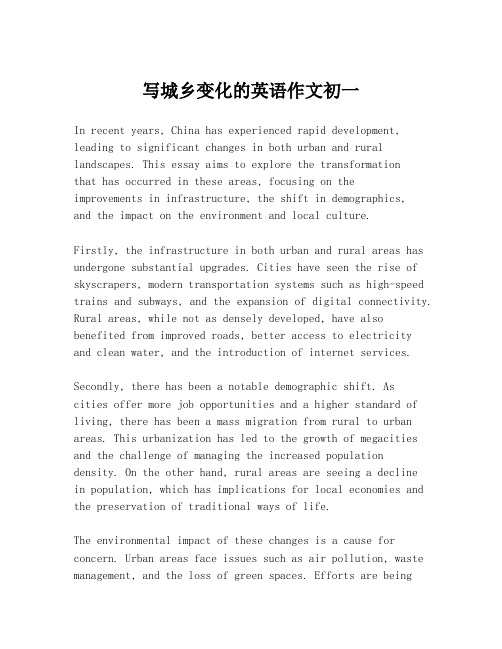
写城乡变化的英语作文初一In recent years, China has experienced rapid development, leading to significant changes in both urban and rural landscapes. This essay aims to explore the transformationthat has occurred in these areas, focusing on the improvements in infrastructure, the shift in demographics,and the impact on the environment and local culture.Firstly, the infrastructure in both urban and rural areas has undergone substantial upgrades. Cities have seen the rise of skyscrapers, modern transportation systems such as high-speed trains and subways, and the expansion of digital connectivity. Rural areas, while not as densely developed, have also benefited from improved roads, better access to electricity and clean water, and the introduction of internet services.Secondly, there has been a notable demographic shift. Ascities offer more job opportunities and a higher standard of living, there has been a mass migration from rural to urban areas. This urbanization has led to the growth of megacities and the challenge of managing the increased population density. On the other hand, rural areas are seeing a declinein population, which has implications for local economies and the preservation of traditional ways of life.The environmental impact of these changes is a cause for concern. Urban areas face issues such as air pollution, waste management, and the loss of green spaces. Efforts are beingmade to create more sustainable cities through the development of eco-friendly technologies and the implementation of green policies. Rural areas, while having less pollution, are not immune to the effects of climate change and the need for sustainable agricultural practices.Lastly, the cultural impact of urbanization is significant. Cities become melting pots of different cultures, which can lead to a rich diversity but also the risk of losing traditional cultural practices. Rural areas, which often hold onto their cultural heritage more tightly, can face the challenge of maintaining their identity as the younger generation moves to urban centers.In conclusion, the changes in urban and rural areas are a testament to the rapid development China has achieved. While these transformations bring about many benefits, they also present challenges that need to be addressed to ensure a balanced and sustainable future for all communities. It is crucial to find a harmonious way to integrate modernization with the preservation of the environment and cultural heritage.。
中国乡村振兴的英语作文
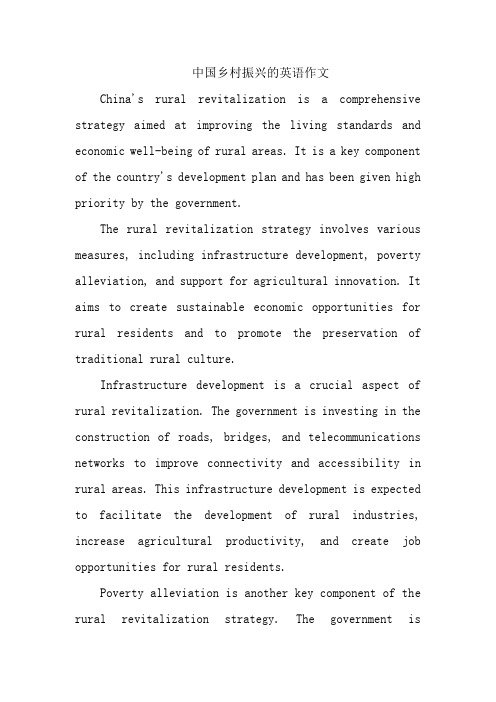
中国乡村振兴的英语作文China's rural revitalization is a comprehensive strategy aimed at improving the living standards and economic well-being of rural areas. It is a key component of the country's development plan and has been given high priority by the government.The rural revitalization strategy involves various measures, including infrastructure development, poverty alleviation, and support for agricultural innovation. It aims to create sustainable economic opportunities for rural residents and to promote the preservation of traditional rural culture.Infrastructure development is a crucial aspect of rural revitalization. The government is investing in the construction of roads, bridges, and telecommunications networks to improve connectivity and accessibility in rural areas. This infrastructure development is expected to facilitate the development of rural industries, increase agricultural productivity, and create job opportunities for rural residents.Poverty alleviation is another key component of the rural revitalization strategy. The government isimplementing various programs to help rural residents improve their living standards and escape poverty. These programs include job training, education support, and financial assistance.Support for agricultural innovation is also an important aspect of rural revitalization. The government is promoting the development of modern agriculture and supporting the adoption of new technologies and practices in rural areas. This is expected to increase agricultural productivity and improve the competitiveness of Chinese agricultural products in the global market.In conclusion, China's rural revitalization strategy is a comprehensive and multifaceted approach to improving the living standards and economic well-being of rural areas. It involves various measures, including infrastructure development, poverty alleviation, and support for agricultural innovation. This strategy is expected to contribute to the sustainable development of rural areas and to promote the preservation of traditional rural culture.中文翻译:中国的乡村振兴是一个旨在改善农村地区生活水平和经济福祉的全面战略。
中国现代化发展的英语文章
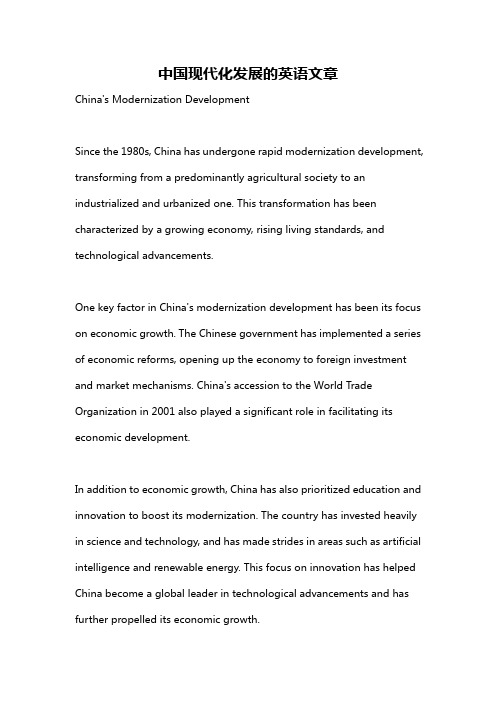
中国现代化发展的英语文章China's Modernization DevelopmentSince the 1980s, China has undergone rapid modernization development, transforming from a predominantly agricultural society to an industrialized and urbanized one. This transformation has been characterized by a growing economy, rising living standards, and technological advancements.One key factor in China's modernization development has been its focus on economic growth. The Chinese government has implemented a series of economic reforms, opening up the economy to foreign investment and market mechanisms. China's accession to the World Trade Organization in 2001 also played a significant role in facilitating its economic development.In addition to economic growth, China has also prioritized education and innovation to boost its modernization. The country has invested heavily in science and technology, and has made strides in areas such as artificial intelligence and renewable energy. This focus on innovation has helped China become a global leader in technological advancements and has further propelled its economic growth.As China continues to modernize, it faces challenges such as environmental degradation, income inequality, and aging population. However, the Chinese government has implemented measures to address these challenges, such as promoting sustainable development and social welfare policies.Overall, China's modernization development has been characterized by rapid economic growth, technological advancements, and improved living standards. With continued efforts to address challenges and foster innovation, China is likely to remain a major player in the global economy.。
